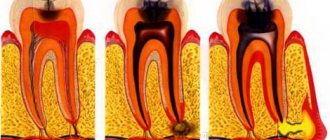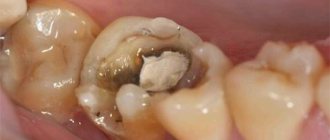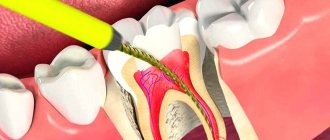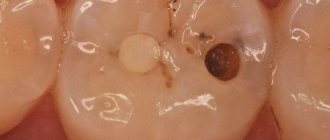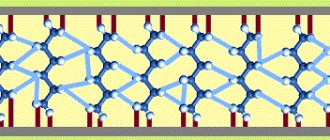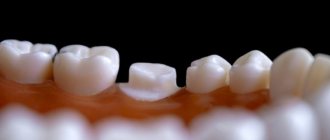It is not always possible to treat a tooth in one visit - if the caries is complicated and the root canals are inflamed, the doctor puts a temporary filling under which he puts medications. It prevents medication from falling out, protects the treated dental cavity from food debris and microbes.
A temporary filling is made of a looser material. It is plastic and does not dissolve in water. For filling, dentin paste, sympath, vinoxol, and zinc-polyacrylate cement are used. The doctor chooses the material, taking into account the diagnosis and the condition of the tooth.
Temporary filling is used for prosthetics, if caries has not reached the nerve, when the nerve is removed. A filling is also installed in the following cases:
- treatment of pulpitis, periodontitis;
- deep caries;
- removal of a tooth root cyst;
- multi-stage therapy;
- making a dental stump inlay when installing a crown.
The period of wearing a temporary filling usually does not exceed 1-1.5 weeks, but sometimes it can be extended up to six months. The dentist determines it exactly.
Sometimes, after installing a temporary filling, patients complain of discomfort and pain. Why does pain occur, how to deal with it?
Indications for placing a temporary filling
- Treatment of deep caries. After cleansing the tooth cavity from necrotic masses, the dentist places a medicinal solution that helps the dentin strengthen the layer between the pulp chamber and the open cavity.
- Diagnosis of the condition of the tooth with deep caries before installing a permanent filling.
- Acute pulpitis. A temporary intermediate composition is placed while the nerve is removed.
- Periodontitis. To relieve inflammation, an antiseptic or medicinal preparation is placed in the area of the tooth roots, which is then covered with light cement.
- Sanitation of dental canals before filling. The doctor cleans the canals, filling them with a disinfectant solution, then places a temporary filling.
- Prosthetics, restoration. The process of making an artificial crown or orthodontic structure takes several days. To protect against microbes, the open tooth cavity is closed with a temporary filling material.
Stages of placing a temporary filling:
- opening the tooth cavity, removing all affected dentin tissue;
- expansion, cleaning, treatment of dental canals;
- therapeutic stage (depending on the diagnosis, the nerve endings of the pulp are removed, medications are placed in the tooth cavity, and the canals are filled with temporary cement);
- The crown is closed with a temporary filling.
Temporary filling hurts when pressed: how to cope with the disease?
People often ask the question: “if you have a temporary filling installed and your tooth hurts, what should you do?” When a tooth hurts under a temporary filling, this is a normal condition, do not panic. If the dentist said that there is no cause for concern, you should be patient and wait out the unpleasant symptom. When a temporary filling causes severe pain in a tooth, and you run out of strength to endure the pain, you can use the following recommendations:
- rinse your mouth with antiseptic and soothing solutions. You can prepare them yourself at home from natural ingredients. For example, chamomile and sage are poured with boiling water and the resulting product is used to rinse the mouth;
- do not allow food and drinks (mainly hot or cold) to come into contact with the treated tooth;
- take a painkiller (analgesic). “Nise” and “Ketorol” give good results;
- make lotions with valerian tincture. A moistened cotton swab of valerian is applied to the painful area, the gum near the tooth. This will temporarily relieve the irritation.
If a tooth hurts after installing a temporary filling and swelling or redness of the soft tissue appears, this may indicate the presence of an inflammatory process or the appearance of pus. In such a situation, you should re-make an appointment with a dentist-therapist. The A-Medic clinic employs qualified specialists with extensive experience. To make an appointment, just fill out the standard form on the official website of the clinic (indicating your full name and contact number). Prices are affordable, and consultation with a dentist is completely free.
Material of manufacture
Requirements for temporary filling materials:
- no toxic effect on tooth structures (enamel, dentin, pulp) and mucous membranes of the oral cavity;
- safety for human health;
- chemical inertness and high resistance to saliva and aggressive environments (alkalies, acids);
- mechanical strength, wear resistance, ductility;
- lack of galvanization effect;
- maintaining shape and size during hardening;
- good radiopacity.
The choice of material for a temporary filling depends on the clinical case, age, individual characteristics of the body (the presence of allergies to certain substances), as well as how long the patient will wear it.
Material requirements
To install a temporary filling, a specialized material is used that can be easily removed by the dentist if necessary. The composition for temporary filling must meet the following requirements:
- X-ray resistant. To check the correctness of the filling, the dentist prescribes an x-ray examination. The image allows you to timely identify the presence of cracks in the filling material and eliminate them.
- Good grip on the surface. It is necessary to exclude the formation of microcracks or incomplete adhesion of the material to the tooth tissue. Violation of this rule may result in medication entering the oral cavity.
- Elasticity. The material should easily fill the pores formed in the tooth tissue.
- Strength. The material is installed by the dentist for a certain period of time. When eating, the filling is subjected to high stress. In this regard, the seal must be resistant to mechanical damage.
- Harmlessness. The filling should not cause allergic reactions or negatively affect human health.
- Easy to remove. At your follow-up appointment, the doctor quickly removes the temporary filling.
A mandatory requirement for temporary material is a high curing speed. The filling completely hardens in 2 – 3 hours.
Intermediate filling materials
- A paste based on zinc sulfate and kaolin allows you to restore the crown of the tooth.
- Karyosan has an analgesic and antiseptic effect.
- Vinoxol is an artificial dentin. Withstands chewing load for up to 1-2 months.
- Cement with zinc and eugenol. It is used for antiseptic treatment of tooth tissue and relief of the inflammatory process.
- Glass ionomer cement is used for temporary fixation of the prosthesis.
- One-component polymer materials are pastes with a viscous consistency that harden under the light of a special lamp.
Signs of a filling falling out soon
How can you tell if a filling has fallen out? This is quite simple - at the place of its installation there is no material with which the filling was made, and there is a hole. Therefore, it is better to prevent such a phenomenon and contact a specialist in advance, even before complete loss.
Determining that the filling does not stay in the tooth and will soon fall out is also quite simple. Gaps appear between the tooth surface and the filling material, which are almost invisible at first, but become larger over time. The material itself becomes loose. This is felt when you press the seal with your tongue. If such phenomena are observed, you should immediately consult a doctor so as not to be annoyed later that the filling has come out.
How long does it take to wear a temporary filling?
Depending on the material of manufacture, a temporary filling has different characteristics of strength and tightness and can last from several days to six months.
Average duration of use of a temporary filling:
- 2-3 days, if a drug is placed under the filling that destroys the nerve endings of the pulp;
- 7–10 days while treatment of the inflammatory process with periodontitis or pulpitis continues;
- 2-3 weeks - for the period of manufacture of the orthopedic structure;
- several months in special diagnostic cases (when treating a dental cyst, restoring dentin after deep caries).
It is necessary to strictly adhere to the timing of wearing temporary fillings. If the time period is extended, its integrity and sealing may be compromised, which will negatively affect the health of the tooth. Thus, arsenic-based paste, if not removed after 2-3 days, begins to penetrate the dentin through the tubules, destroying bone tissue.
How long a temporary filling can be worn is decided by the attending physician, depending on the diagnosis and the chosen treatment method.
Removing a temporary filling is a mandatory procedure before placing a permanent filling. After removal of the temporary composite, antiseptic treatment of the root canals and dental cavity is carried out. Next, a permanent filling is installed.
Why a temporary filling is placed: types of material
Non-permanent filling is a mandatory measure in the treatment of complicated carious lesions and root canal inflammation. It is required for medicinal treatment of an inflamed molar or premolar. It is entrusted with the protective function of the treated cavity from food ingress. Also, it prevents the medical pad from falling out.
The composition of such material differs significantly from a permanent filling. It can be made from water-insoluble or plastic components. The choice of the most suitable material directly depends on the condition of the molar or premolar and the purpose of the installation. Among the most common materials are:
- sympath. It can be of different shades - white (for filling non-pulp teeth) or light pink. The mass does not provoke irritation and other allergic reactions;
- dentin paste. It reliably protects the tooth from staining with amalgams and is characterized by water-repellent properties. The paste hardens in 100-120 minutes;
- zinc polyacrylate cement. It is characterized by good biocompatibility with tissues and high strength. The material is used for fixing prostheses (crowns) or filling (both permanent and baby teeth);
- Vinoxol. It is characterized by reliability and durability, capable of maintaining integrity for up to 4-5 months. The drug has antiseptic properties, which allows you to disinfect the tooth cavity. It hardens in 3-4 hours.
There are situations when the carious lesion did not have time to reach the nerve. In such cases, the molar or premolar is not depulped, but temporary material is installed. This is necessary for diagnosis to see whether the tooth will become sensitive or not. With the help of these measures, it is possible to completely preserve a molar or premolar (without removing the nerve) if the patient does not experience pain. If a pronounced reaction occurs (if the temporary filling hurts), the dentist will remove the nerve after placing a filling with arsenic.
Often, non-permanent filling is resorted to during prosthetics. This allows you to protect the molar or premolar from pathogenic microorganisms. The wearing period is individual and directly depends on the type of material and the reason why filling was required. It is installed by the attending dentist. On average, after 7-10, specialists replace it with a permanent filling. Sometimes, after applying a temporary filling, a tooth hurts; let’s figure out what could cause this phenomenon.
Problems that arise when installing a temporary filling
Painful sensations can be caused by an incompletely destroyed nerve, infection under the filling, or the development of inflammation.
The filling falls out or crumbles. If you do not immediately consult a dentist, the treatment will have to begin again with re-sanitation of the canals, treating them with antiseptics to stop the development of infection.
An unpleasant taste in the mouth often indicates depressurization of the temporary coating, when the medicine from the tooth begins to leak into the oral cavity.
Darkening of the filling, swelling or redness of the gums may be signs of an allergic reaction to a component of the filling material.
What to do if your tooth hurts
Discomfort and pain in the first days after the procedure are normal. If pain persists, you should consult a doctor. He will perform diagnostics and give recommendations.
If it is impossible to see a dentist, the following measures will help alleviate the condition:
- taking analgesics - Ketorola, Naiza, Analgin: these medications will relieve pain;
- rinsing the mouth with herbal infusions based on chamomile, sage, eucalyptus: the plant material is poured with boiling water, left for about an hour, cooled and filtered;
- rinsing the mouth with a solution of soda and salt;
- you can make a lotion from valerian infusion: soak a cotton swab in the infusion, apply to the gum next to the damaged area;
- if swelling has developed as a result of inflammation, antihistamines will help reduce it;
- Gels containing painkillers will help eliminate discomfort.
Important: these are temporary measures designed to alleviate the condition, and not an alternative to going to the doctor. Visit your dentist as soon as possible!
Destruction of the seal
Has the filling broken? This is evidence of its gradual destruction. This phenomenon can occur for various reasons. The main ones:
- Too much zeal when carrying out hygiene procedures. Frequent use of a hard brush can cause damage to the filling material or enamel.
- Large loads on the tooth. They occur when eating solid foods, seeds, nuts and the like.
- Poor quality filling material.
- Failure of a specialist to comply with the technological process.
What to do if a piece of the filling breaks off and your tooth hurts? This indicates that the material does not adhere tightly to the surface and a gap has arisen between the filling and the tooth. Pain is a consequence of the inflammatory process. If the pathology is not eliminated, it will develop and cause various diseases.
If a filling breaks on a dead tooth, a crown will have to be placed in any case. If a problem arises on a front tooth that is still alive, the doctor will suggest depulping it and then installing a crown as well.
What causes a temporary filling to fall out?
A patient may have a temporary filling fall out due to medical negligence:
- if the doctor did not properly dry the tooth cavity after pre-treatment or saliva got there before applying the filling material;
- if, after cleaning the carious cavity, particles of infected tissue remain;
- if the surface is not processed well enough, which will cause the enamel to destroy the material;
- if the filling is placed on a pulpless tooth, in this case it cannot hold tightly, because the surface of the unit is fragile, nutrients do not reach it;
- if low-quality or expired materials were used to create a temporary filling;
- if the tooth is severely affected by caries and the filling does not have the necessary support.
But not only the doctor can be the culprit of the problem. A temporary filling falls out when the patient does not adhere to the recommendations received after dental procedures. For example, he decides to have a snack immediately after leaving the doctor's office. Despite the fact that you need to refrain from eating for 1-2 hours. In addition, the filling may fall out if there is a large load on it (when chewing nuts and candies, opening bottles with teeth, biting thread, etc.). Its gradual loosening is provoked by chewing gum and toffee candies, toffees.

